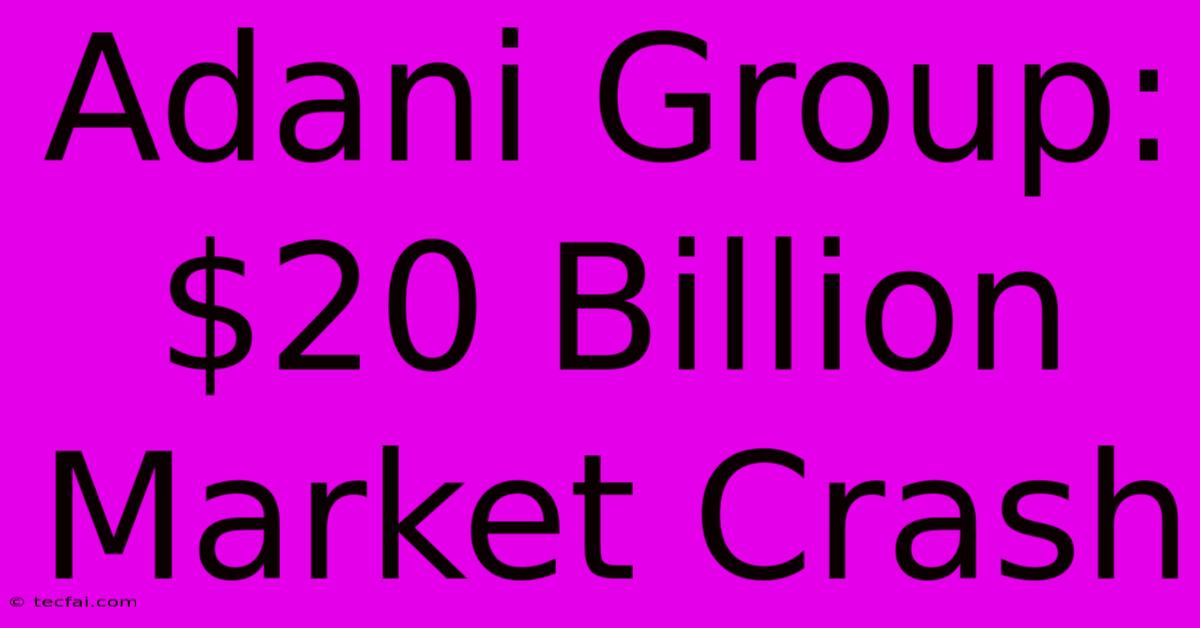Adani Group: $20 Billion Market Crash

Discover more detailed and exciting information on our website. Click the link below to start your adventure: Visit Best Website tecfai.com. Don't miss out!
Table of Contents
Adani Group: The $20 Billion Market Crash – A Deep Dive into the Crisis
The Adani Group, once a symbol of India's burgeoning economic power, experienced a dramatic and unprecedented market crash in late January 2023, wiping out nearly $20 billion in market value. This seismic event sent shockwaves through global markets and sparked intense scrutiny of the conglomerate's financial practices and corporate governance. This article delves into the details of the crisis, exploring its causes, consequences, and potential long-term implications.
The Hindenburg Report: The Catalyst for Collapse
The catalyst for the Adani Group's downfall was a scathing report published by Hindenburg Research, a US-based short-selling firm. The report accused the Adani Group of decades-long stock manipulation and accounting fraud, alleging the use of offshore shell companies to inflate its share prices artificially. The report detailed complex web of transactions, raising serious questions about the group's financial transparency and ethical conduct. This explosive report triggered a domino effect, leading to a massive sell-off of Adani Group stocks.
Market Reaction and Global Implications
The market reacted swiftly and decisively. Within days of the Hindenburg report's publication, the Adani Group's market capitalization plummeted by billions of dollars. Investors, spooked by the allegations of fraud and the potential for further losses, scrambled to divest their holdings. The crash wasn't confined to India; it had global ramifications, impacting investor confidence in emerging markets and raising concerns about corporate governance standards in developing economies. The ripple effect was felt across various financial sectors, highlighting the interconnected nature of the global financial system.
Adani Group's Response and Damage Control
The Adani Group vehemently denied all allegations made in the Hindenburg report, calling it a "malicious" attempt to damage its reputation. The group issued a detailed rebuttal, attempting to address each of the points raised in the report. However, this response, while comprehensive, failed to fully quell investor concerns. The damage to the group's reputation was significant, and regaining investor trust will be a long and arduous process. Further investigations by regulatory bodies will be crucial in determining the veracity of the allegations.
The Aftermath and Long-Term Consequences
The aftermath of the $20 billion market crash continues to unfold. While the immediate impact was devastating, the long-term consequences are yet to be fully understood. The crisis raises serious questions about the role of regulatory bodies in overseeing large conglomerates and the need for greater transparency and accountability in corporate governance practices. The incident also serves as a cautionary tale for investors, highlighting the risks associated with investing in emerging markets and the importance of conducting thorough due diligence before making investment decisions.
Lessons Learned and Future Outlook
The Adani Group crisis serves as a stark reminder of the potential for rapid and significant market volatility. It also underscores the crucial role of independent oversight and robust regulatory frameworks in maintaining market stability and investor confidence. The long-term implications for the Adani Group, the Indian economy, and the global financial landscape remain to be seen. However, this event will undoubtedly lead to increased scrutiny of corporate governance practices and a renewed focus on ethical investment strategies. The future success of the Adani Group will depend heavily on its ability to restore investor confidence, address the allegations, and implement meaningful reforms to improve its transparency and accountability.
Keywords: Adani Group, market crash, Hindenburg Research, stock manipulation, accounting fraud, corporate governance, India, global markets, investor confidence, emerging markets, financial crisis, regulatory oversight.

Thank you for visiting our website wich cover about Adani Group: $20 Billion Market Crash. We hope the information provided has been useful to you. Feel free to contact us if you have any questions or need further assistance. See you next time and dont miss to bookmark.
Featured Posts
-
Sa Banke Hoe Winste Behaal
Nov 22, 2024
-
Ind Vs Aus Predicted Playing Xi
Nov 22, 2024
-
Jonathan Toews India Health Journey
Nov 22, 2024
-
Body Discovered In North Belfast Vehicle
Nov 22, 2024
-
Summer Food Science School Penn State
Nov 22, 2024
